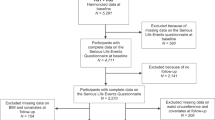Abstract
Background
Patients after their first myocardial infarction are characterized by increased levels of perceived stress and abdominal obesity compared to a matched control group. In the setting of primary prevention, the association of stress and cardiovascular risk factors in obese and non-obese individuals is not known.
Methods and results:
For this prospective cross-sectional study, primary care physicians recruited consecutive patients with BMI >30 and the next two individuals presenting with a BMI <30 as controls (n=414). The 10-year risk of death from cardiovascular disease determined by the European Society of Cardiology Heart- Score Germany was associated with BMI (p<0.0001). However, waist circumference and waist-tohip ratio predicted the calculated cardiovascular risk better than BMI. Psychosocial risk factors were determined using the INTERHEART questionnaire. Obesity was positively associated with depression (p=0.005) but not with perceived stress. In contrast to obesity or depression, the extent of perceived general stress inversely correlated with cardiovascular risk (never stress: 4.4±2.8%, some period: 2.4±2.7%, several periods: 1.4±2.3% and permanent: 0.65±0.5%; p=0.0001). Similarly, additional parameters of stress (stress at home, stress at work, financial stress, stressful life events) as well as locus of control were inversely associated with cardiovascular risk factors. A medical history of general stress was correlated with younger age and increased smoking.
Conclusions
Waist to hip ratio powerfully predicts the cardiovascular risk estimated by HeartScore in primary prevention. Perceived stress assessed by a standardized questionnaire does not positively correlate with traditional cardiovascular risk factors and warrants further evaluation as a routine tool for primary care physicians.
Similar content being viewed by others
References
de Backer G, Ambrosioni E, Borch- Johnsen K et al (2003) European guidelines on cardiovascular disease prevention in clinical practice: third joint task force of European and other societies on cardiovascular disease prevention in clinical practice (constituted by representatives of eight societies and by invited experts). Eur J Cardiovasc Prev Rehabil 10:S1–S10
Grundy SM, Pasternak R, Greenland P et al (1999) Assessment of cardiovascular risk by use of multiple-riskfactor assessment equations: a statement for healthcare professionals from the American Heart Association and the American College of Cardiology. Circulation 100:1481–1492
Assmann G, Cullen P, Schulte H (2002) Simple scoring scheme for calculating the risk of acute coronary events based on the 10-year follow-up of the prospective cardiovascular Munster (PROCAM) study. Circulation 105:310–315
Conroy RM, Pyorala K, Fitzgerald AP et al (2003) Estimation of ten-year risk of fatal cardiovascular disease in Europe: the SCORE project. Eur Heart J 24:987–1003
Keil U, Fitzgerald AP, Gohlke H et al (2005) Risk Stratification of Cardiovascular Diseases in Primary Prevention — The New SCORE-Deutschland Risk Charts. Deutsches Ärzteblatt 102:1808–1812
Yusuf S, Hawken S, Ounpuu S et al (2004) Effect of potentially modifiable risk factors associated with myocardial infarction in 52 countries (the INTERHEART study): case-control study. Lancet 364:937–952
Yusuf S, Hawken S, Ounpuu S et al (2005) Obesity and the risk of myocardial infarction in 27,000 participants from 52 countries: a case-control study. Lancet 366:1640–1649
Rosengren A, Hawken S, Ounpuu S et al (2004) Association of psychosocial risk factors with risk of acute myocardial infarction in 11119 cases and 13648 controls from 52 countries (the INTERHEART study): case-control study. Lancet 364:953–1062
Rozanski A, Blumenthal JA, Davidson KW et al (2005) The epidemiology, pathophysiology, and management of psychosocial risk factors in cardiac practice: the emerging field of behavioral cardiology. J Am Coll Cardiol 45:637–651
Bunker SJ, Colquhoun DM, Esler MD et al (2003) Stress and coronary heart disease: psychosocial risk factors. Med J Aust 178:272–276
Kuper H, Marmot M, Hemingway H (2002) Systematic review of prospective cohort studies of psychosocial factors in the etiology and prognosis of coronary heart disease. Semin Vasc Med 2:267–314
Zellweger MJ, Osterwalder RH, Langewitz W et al (2004) Coronary artery disease and depression. Eur Heart J 25:3–10
Rees K, Bennett P, West R et al (2004) Psychological interventions for coronary heart disease. Cochrane Database Syst Rev CD002902
Author information
Authors and Affiliations
Corresponding author
Rights and permissions
About this article
Cite this article
Lahiri, K., Rettig-Ewen, V., Böhm, M. et al. Perceived psychosocial stress and cardiovascular risk factors in obese and non-obese patients. Clin Res Cardiol 96, 365–374 (2007). https://doi.org/10.1007/s00392-007-0512-1
Received:
Accepted:
Published:
Issue Date:
DOI: https://doi.org/10.1007/s00392-007-0512-1




